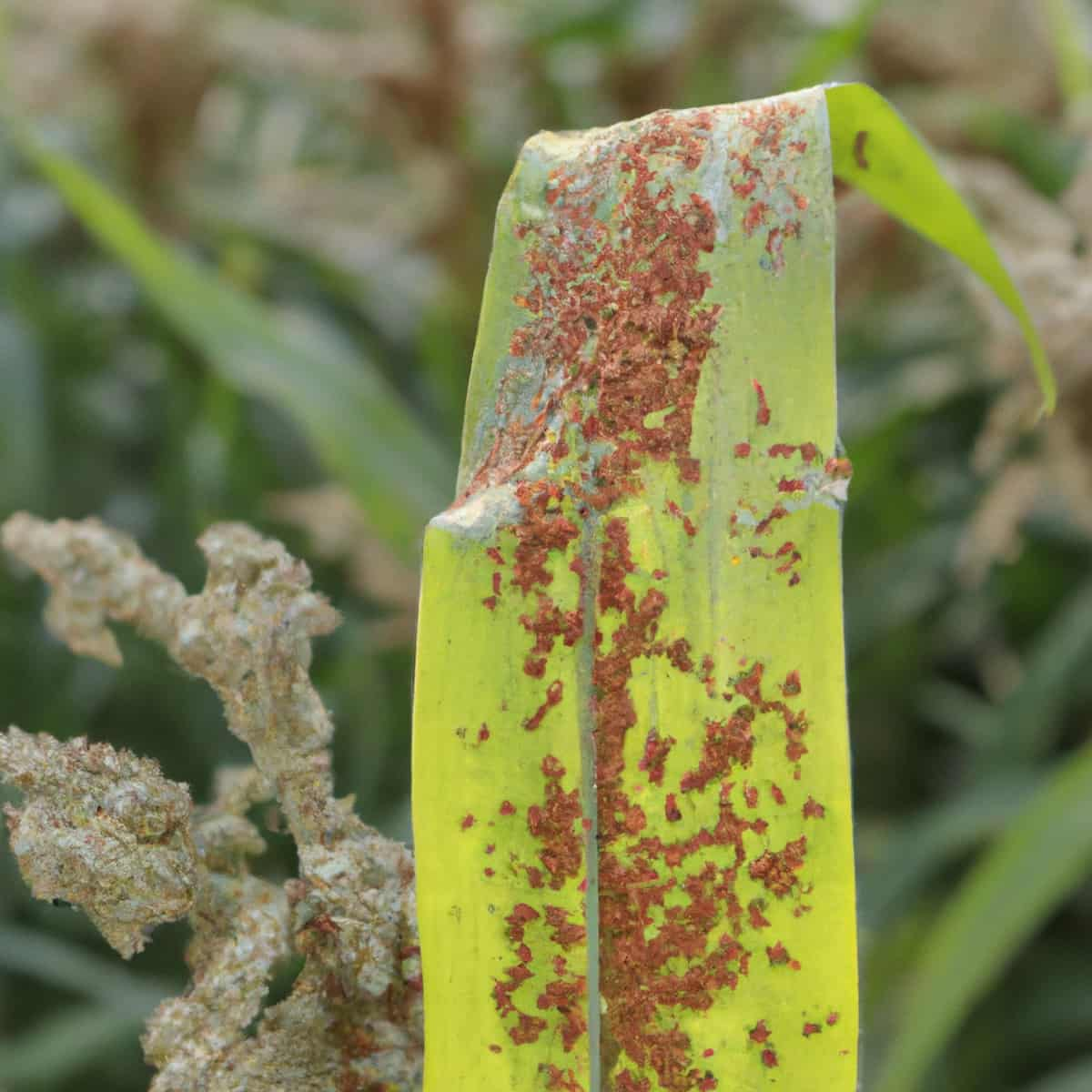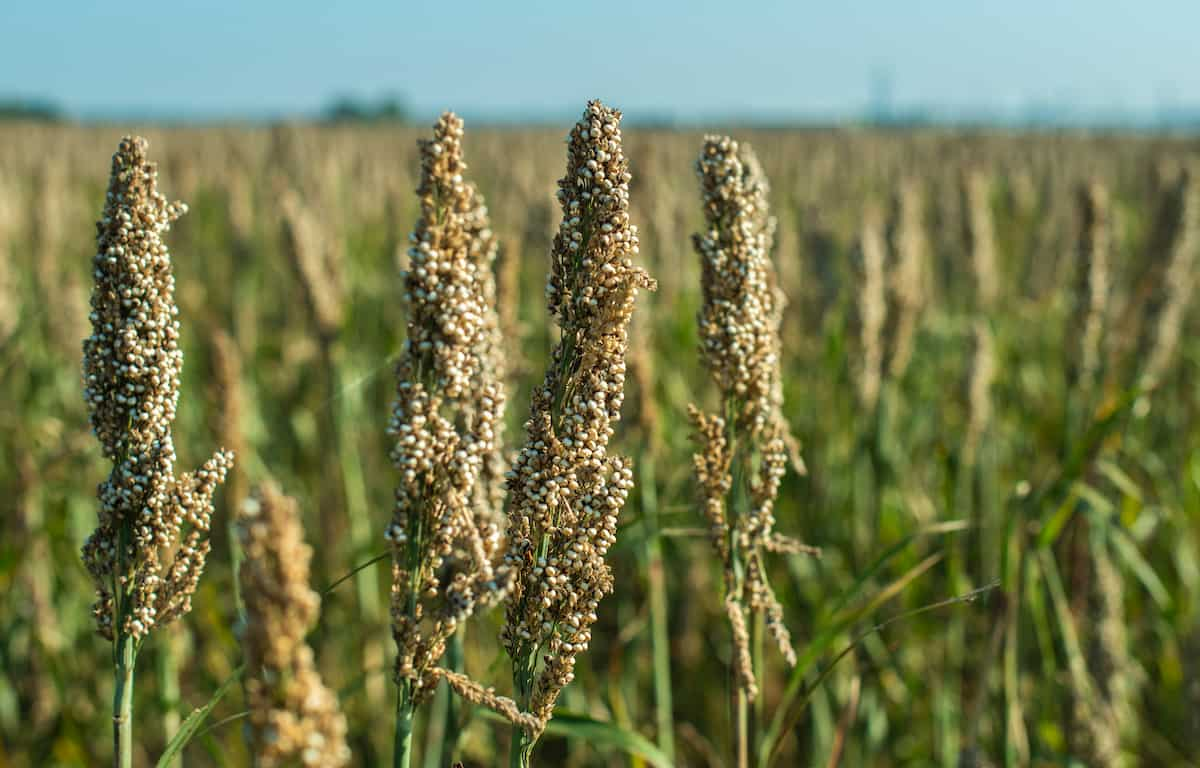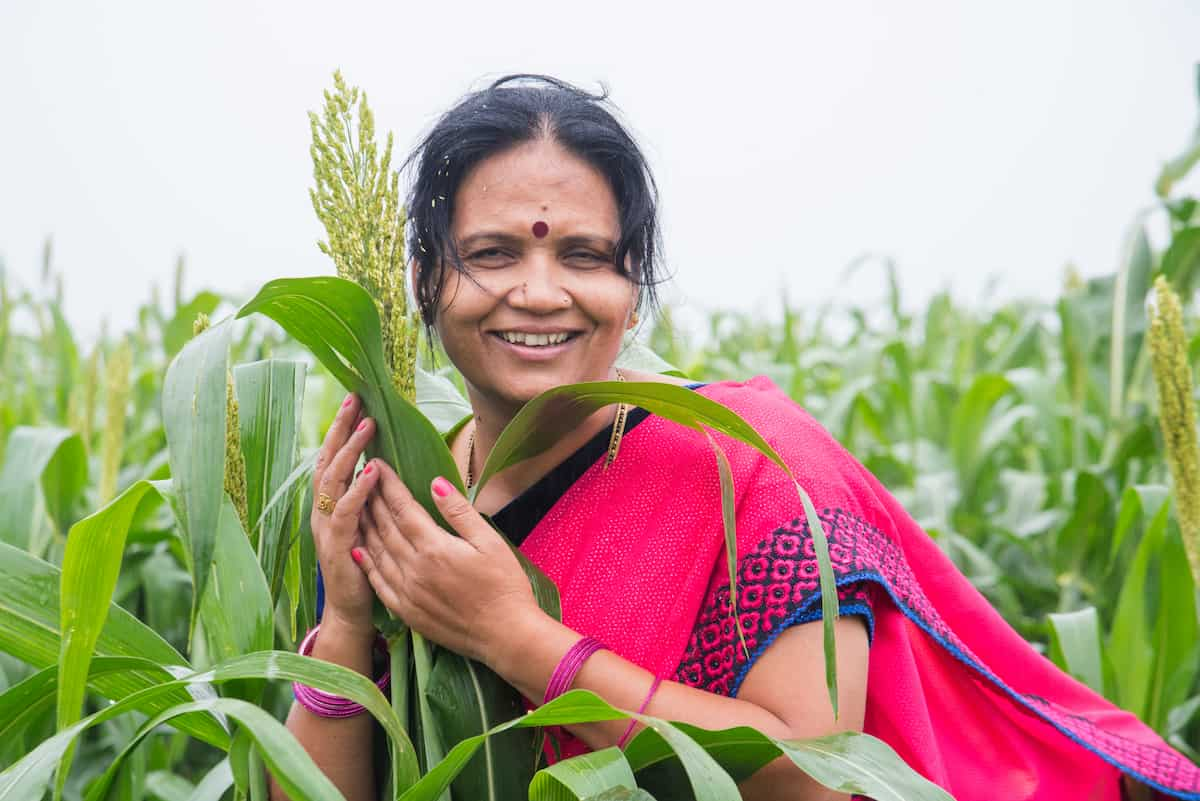Sorghum downy mildew, or Sclerospora sorghi, is a devastating fungal disease that can cause significant losses worldwide. The disease is severe especially in areas with warm and wet environments, where the fungus is able to spread rapidly. Therefore, itrghum producers need to understand the disease cycle, its interaction with the environment and risk factors to prevent and manage this disease.

Cultural practices, such as crop rotation and the use of resistant varieties, must be practiced. This article will provide an overview of sorghum downy mildew disease, including its symptoms, biology, and control.
Downy Mildew Disease Management in Sorghum
The Causal Organism of Sorghum Downy Mildew Disease
- Peronosclerospora sorghi, the pathogen is white, filamentous, oomycete, systemic and obligate parasite, has a wide host range, attacking sorghum, maize, millet and wheat. It produces intercellular, aseptate mycelium capable of infecting all parts of the plant.
- Sporangiophores sprout out via the stomatal pores, either solitary or sometimes in bunches, robust and dichotomously divided.
- Spores are globular, uni-cellular, transparent, and thin-walled, and can remain viable in the soil for atleast 4 years. The dark brown, thick walled oospores are shaped like a sphere.
The Disease Cycle of Sorghum Downy Mildew Disease
- The disease cycle begins when the fungus infects the sorghum plant through meristematic tissue. Infection occurs when the spores land on the leaves of the plant and germinate.
- The germinated spores then produce hyphae, or filaments, which penetrate the leaf epidermis and cause infection. Tissue degradation results in long and narrow cuts on the plant. The favorable temperature for the formation of conidia in huge quantities is 20-23°C at night.
- The disease continues to persist on the collateral host, Heteropogen centortus.
Mode of Spread and Survival of The Pathogen in Sorghum Crop
- Control of the disease is difficult, as the fungus persists in the soil and plant residues as oospores, primary source of the systemic infection.
- Sporangia carried by wind currents are the secondary source of infection. The presence of mycelium in the seeds of infected plants is another source of infection.
Causes / Conditions Favorable for Sorghum Downy Mildew Disease Spread in The Field.
- High Relative Humidity – RH at 100% results in maximum spore formation.
- Temperature – Favorable temperature for spore formation is 21-23°C at night.
- Climate – Cooler climatic conditions along with slight drizzling favors disease spread.
Symptoms of Sorghum Downy Mildew Disease
The most common symptom is the presence of white, downy mildew on the leaves of infected plants. These patches of mildew are oval shaped, will often start at the base of the leaf and spread along the veins. As the disease progresses, these patches of mildew will darken, eventually turning gray or black. The lesions can coalesce and form large patches on the leaves. Small, black, round spores may also be visible on the affected leaves’ undersides.
Oospores are released by disintegrating interveinal tissues of leaves resembling typical shredded leaf symptoms. Yellow spots on the leaves, reduced head size, and seed yields are other disease symptoms. In addition to the visible symptoms, the plant may experience stunted growth, and the leaves may become distorted or yellowed. In severe cases, the plant may die, reducing yield.
Percentage of Yield Loss Due to Sorghum Downy Mildew Disease in Sorghum Crop
- SDM can cause losses up to a maximum of 80% yield worldwide. It has caused significant losses in many countries, including India, Ethiopia, and the United States.
- The losses have been estimated at 10-40% in India, > 70% in Ethiopia, and 0.5-5% in the United States.
In case you missed it: Charcoal Rot Disease Management in Maize: Symptoms, Treatment, Chemical, Biological, Natural, and Organic Control

Diagnosis of Sorghum Downy Mildew Disease in Sorghum Crop
Generally 3-4 leaves develop chlorotic downy symptom and the rest develops bleached symptom in stripes. They disintegrate the interveinal tissues of leaves and exhibit typical shredded leaf symptom leaving the xylem and phloem loosely adhered.
Cultural Control Measures of Sorghum Downy Mildew Disease
- To be successful, cultural control should be implemented before the disease appears in the crop.
- Soil Fertility: Optimizing soil fertility will ensure that the crop is growing in a favorable environment and will reduce the disease incidence.
- Crop Rotation: It is important to not plant sorghum in the same field year after year. And rotate sorghum with pulses and oilseeds.
- Collateral Host: The Heteropogen Centortus should be removed in the crop as it helps the pathogen to persist.
- Inter-cropping: Planting a variety of crops will help to reduce the spread of SDM.
- Resistant Varieties: Planting moderately resistant varieties like Co25 and Co26 can reduce the risk of SDM and minimize the need for chemical control.
- Proper Irrigation: It can also help reduce the severity of the disease by keeping the leaves dry and reducing the amount of moisture in the environment, thus, reducing the spread of spores.
- Planting Time: It is important to avoid planting at times when SDM is most likely to occur. SDM is most severe in wet, cool conditions. Therefore, planting should be avoided during these times. Additionally, the crop should be started early so that it can mature before the conditions become favorable.
- Roguing Out: Destruction of infected plants is necessary to prevent the secondary spread of the disease by wind.
Biological Control Measures of Sorghum Downy Mildew Disease
- Biological control of SDM in Sorghum is a form of pest management that relies on natural predators, parasites, and pathogens to control disease-causing organisms.
- Parasitic fungi, such as Cladosporium cucumerinum, Trichoderma viride, and Trichoderma harzianum, produce substances that inhibit the growth of the fungal pathogen responsible for the disease.
- Predators, such as the predatory mite Phytoseiulus persimilis, feed on the fungal spores of the pathogen, thereby reducing the number of spores present in the environment.
- Pathogens, such as the bacterium Pseudomonas syringae, can be used to reduce the severity of the disease by competing with the pathogen for nutrients and space.
In case you missed it: Common Rust Disease Management in Maize: Symptoms, Treatment, Chemical, Biological, Natural, and Organic Control

Chemical Control Measures of Sorghum Downy Mildew Disease
- Chemical control can be expensive and time-consuming. Therefore, research into more effective and efficient strategies for controlling this disease is necessary.
- Seed treatment with Metalaxyl fungicide at 6 grams/ kg of seed sown.
- Foliar spray application of Metalaxyl at 500 grams/ha or Mancozeb 2kg/ha or Ziram 1kg/ha of Zineb 1kg/ha.
- In addition to above, other fungicides such as chlorothalonil and tebuconazole may also be used to control this disease during early stages. It is important to apply fungicides at regular intervals during the growing season.
Preventive Measures for Control of Sorghum Downy Mildew Disease
- Sanitation: Sanitation is an important measure for controlling SDM. The infected plants should be removed and destroyed in order to reduce the spread of the pathogen. All plant debris should be removed from the field and destroyed in order to reduce the chances of further infestation.
- Plant spacing: Planting too close together can increase the spread of SDM.
- Nutrient management: Low levels of Nitrogen can lead to increased susceptibility to the disease.
- Pruning and Thinning operations can help reduce the spread of the disease.
Conclusion
This disease was first reported in India in 1897, and has since spread to many parts of the world. Resistant varieties are available, but may not be suitable for all areas. Chemical fungicides should be applied preventively and at the first sign of infection. Application should be repeated at regular intervals, as the pathogen can quickly build up a tolerance to fungicides.
- Natural Solutions for Pest Control in Flower Gardens
- Types of Fungicides Used in Agriculture
- Common Issues in the Fruit Development Stage of Pomegranate Farming
- Fruit Development Issues in Papaya: Easy Solutions and Treatment
- Soil-Borne Diseases and How to Protect Your Plants
- Practices to Prevent Disease Spread in the Garden
- From Wilted to Thriving: How to Treat Root Rot Naturally in Houseplants
- Natural Remedies to Cure Brown Spots on Fig Tree Leaves
- Natural Solutions for Poinsettia Problems: 100% Effective Remedies